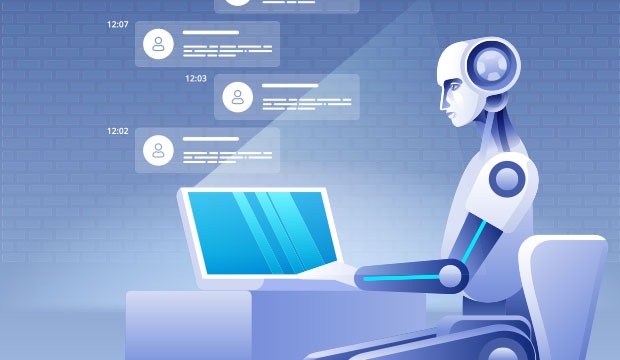Companies across industries are shifting toward an automated approach to customer relations. With the help of chatbots, businesses can reduce their customer service costs by up to 30 percent and save both employees’ and customers’ valuable time.
In fact, many customers welcome chatbots in the customer service process.
So, if chatbots offer all of these advantages, why not scrap your customer service team altogether and automate everything?
Not so fast. While chatbots certainly have their benefits for customer service, they are still a long way from being sophisticated enough to deal with all client interactions — and many customers still prefer speaking to an actual human.
In fact, an increasing number of consumers prefer a combination of automation and human-led interactions. Both of these approaches can help companies reach the top of their customer service game.
First, what actually are chatbots, and how is AI advancing them?
Chatbots Have a Lot to Offer
Chatbots are applications that interact with humans via text through various platforms and for various purposes. These days, businesses primarily use chatbots to facilitate online ordering, make product suggestions, offer personal finance assistance, maintain schedules, and of course — provide customer support.
The chatbot industry is booming, with a market value estimated to reach $10.08 billion by 2026. From startups to enterprises, businesses across the spectrum are realizing the value of chatbots for driving efficiency and their bottom lines.
In fact, 80 percent of business decision-makers planned to start using a chatbot in some way or another by 2020, an Oracle survey found.
So, how are chatbots proving to be so beneficial?
When used correctly, customer service chatbots can save companies serious amounts of time and money. A well-developed chatbot can improve response time and customer satisfaction and help retain vital customers.
Being a technology and not a human representative, chatbots have infinitely more scaling potential. Think of it like this: A human-based customer service interaction is one-to-one between a live agent and a customer. A chatbot has the ability to interact with hundreds or thousands of people at the same time, who never will experience a drop in quality or response time.
Just to give an indication of how much time can be saved by chatbots: In an average 6-minute customer service call, 75 percent of the time is spent doing manual research, while only 25 percent is devoted to customer interaction. Not to mention, the wait time customers have to spend to get through to an agent in the first place is non-existent with chatbots.
This not only saves companies the resources they’d otherwise channel into employing human agents but also makes their business contactable 24/7. Chatbots for customer service will help businesses save an astounding total of US$8 billion per year by 2022, research from IBM indicates.
However, it’s important to note that chatbots can vary wildly in their capabilities, and companies looking for top-of-the-range tech should prioritize the inclusion of technologies like artificial intelligence (AI) and natural language processing (NLP). Let’s take a look at what chatbots need to include to please customers rather than push them away.
All Chatbots Are Not Created Equal
When looking to leverage chatbots to drive efficiency in customer service, businesses often deploy rudimentary, path-based bots that are unable to engage in natural-sounding conversation and deliver accurate responses.
Using such chatbots can be risky. Seventy-three percent of users recently surveyed would not return to a chatbot they deemed unhelpful the first time they used it. Bad chatbots could end up driving your customers away.
So, what makes good chatbots good?
Advanced AI and NLP technologies ensure that customer-chatbot interactions are more informative and fluid. Chatbots embedded with these functionalities can understand the context around requests, engage in free-flowing conversation, and learn from the data they collect over time. This means that, in many cases, customers can get meaningful and relevant answers in a matter of milliseconds.
When should businesses apply chatbot technology, and when should they opt for human-led interactions?
When to Use Chatbots
As they currently stand, the majority of chatbots are great for answering simple requests and minor troubleshooting. In fact, many customers prefer to troubleshoot on their own before talking to a live agent, which is when chatbots can be incredibly useful.
For example, basic chatbots can answer high-frequency questions on things like opening hours and location, which don’t require human intervention to explain. Businesses that experience many of these types of low-value queries would benefit greatly from chatbots.
A top-of-the-line chatbot that includes AI and NLP can respond to customer requests using conversational language or handle more complex queries involving specific products.
Chatbots are a great option when customer service representatives are offline or overloaded with work. Chatbots can deal with multiple requests at a time and never need time off. You can utilize them as a tool that allows your customers to contact your business at any time.
When Human-Led Customer Service Is Best
Despite the time and money-saving potential of chatbots for businesses, the reality is that many people still want to speak to an actual person, especially when the issue is complicated. Customers found that live chats with humans consistently outperformed chatbots for a range of reasons, including great customer experience and ease of communication, according to this 2019 report.
Evidently, people are still wary that a chatbot won’t be able to resolve their query from start to finish. It pays to make sure your customers have access to a live agent when a complex or technical request requires human judgment and intuition.
Most chatbots are unable to detect when someone is becoming irate. They cannot manage delicate situations or determine when to offer a discount or upgrade to dissatisfied customers in the same way a human can.
Customers often spend time attempting to resolve an issue with a chatbot, only to be transferred to a live agent after having failed to get an answer from the bot, at which point they are already frustrated. In cases like these, it’s best to have an agent on the case from the beginning.
People generally had good experiences with chatbots — up to a point, based on one recent poll. Of the people surveyed, 51 percent said they were open to using a chatbot when the issue was a simple one, whereas, with more complex problems, 57 percent said they would prefer to wait 10 minutes to get help from a human.
Human customer service representatives are better at identifying upselling opportunities and giving a conversation a personal touch that could make customers more receptive to additional purchases. While AI chatbot technology is developing fast, it’s still a long way from being able to match the nuances of human-led conversations.
Generational Preferences
While it’s clear that consumers have distinct preferences when it comes to a chatbot or human-led interactions, there is some variation across demographics on these choices. Businesses should take this into account and look at their customer segments. Are their customers likely to feel more comfortable with a human on the line, or are they open to chatbots?
Unsurprisingly, millennials and Generation Z are leading the way in chatbot usage, with the number of consumers that prefer a live agent declining with each older generation. Younger generations, however, are more demanding when it comes to a seamless digital experience switching between channels. This means that if you’re offering a combined chatbot and human agent customer service experience, the transition between the two should be easy and straightforward.
Better Together
Ultimately, you shouldn’t feel that you have to choose between chatbots and humans in your customer service strategy. If you are considering using a chatbot, make sure you first have identified the problem area it will help to address. Will it be dealing with the simple queries your agents often receive? Or does it need to have specialized knowledge of a certain product?
Once you have the goals and purposes of your chatbot clear, you can ensure that your live agents spend their time efficiently and use the technology to complement their own tasks. With the time and money-saving promise of chatbots, along with live agents’ guarantee of a great customer experience, you’ll be well on your way to customer service success.














































AI-powered chatbots have become widely available and let you do what was once impossible: help customers 24/7, answer questions without any human intervention and provide support to multiple customers at once.